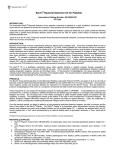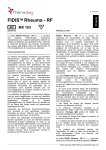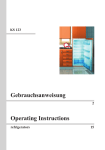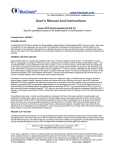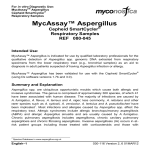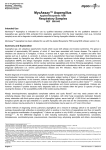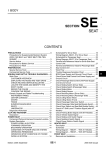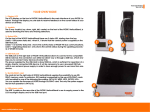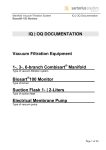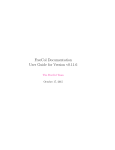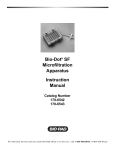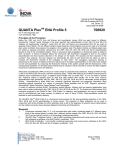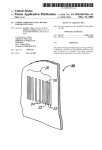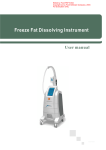Download BacTx® Bacterial Detection Kit for Platelets
Transcript
® BacTx® Bacterial Detection Kit for Platelets Immunetics Catalog Number: DK-B502-032 32 Tests INTENDED USE: ® ® The Immunetics BacTx Bacterial Detection Kit for detection of bacteria in platelets is a rapid, qualitative colorimetric assay for the detection of aerobic and anaerobic Gram-positive and Gram-negative bacteria in pools of up to six (6) units of leukocyte reduced whole blood-derived platelets (Platelets, Leukocytes Reduced) that are pooled within four (4) hours of transfusion as a quality control test. INTRODUCTION: Bacteria are the most common contaminating infectious agents found in platelet units. It has been estimated that the rate of bacterial contamination for apheresis platelet donations is 1 in 5000, making platelets the most frequent source of transfusion1 º related infection . Since platelets must be stored at 20 - 24 C in order to maintain function, small numbers of bacteria that are 2 mostly introduced from a donor’s skin flora into platelet units can multiply to very high numbers in a matter of days . Skin flora are not the only source of bacteria that contaminate platelet units; many strains of Gram-positive and Gram-negative bacteria have been identified in contaminated platelet units, including Staphylococcus, Pseudomonas, Bacillus, and Streptococcus 3 species . To increase transfusion safety, the AABB issued directive 5.1.5.1 in March 2004 requiring blood banks and 4 transfusion services to implement bacterial testing methods on all platelet units . Further safeguards were made effective in January 2011 with the implementation of AABB Interim directive 5.1.5.1.1, which specified that such bacterial testing methods 5 must have prior FDA clearance or must demonstrate equivalent sensitivity to FDA-cleared methods . ® The BacTx Kit is a qualitative colorimetric assay which detects bacteria in platelet samples through recognition of peptidoglycan, a ubiquitous component of bacterial cell walls. The kit consists of lyophilized peptidoglycan detection reagents, sample preparation reagents, controls and microfuge tubes. In the presence of peptidoglycan, the assay generates a redcolored product indicating the presence of bacteria in the platelet sample. The reaction product is detected by a photometer and results interpreted automatically by PC-based software. PRINCIPLE: ® The BacTx Assay detects bacteria in pools of leukocyte reduced whole blood-derived platelets (LR-WBDPs). Gram-positive, ® Gram-negative, aerobic and anaerobic bacteria are expected to be recognized by the BacTx Assay. This test detects the presence of peptidoglycan (PG), which is a component of bacterial cell walls in both Gram-positive and Gram-negative bacteria. To test pooled platelets for the presence of bacterial PG, a small volume of platelets (0.5 mL) is sterilely sampled from the platelet bag and added to a microfuge tube containing 1 mL of Lysis Reagent and mixed by inversion. The microfuge tube is briefly centrifuged to pellet insoluble platelet debris and bacterial cell wall fragments, if present. The pellet is then homogenized in 0.5 mL of Extraction Reagent, by pipetting up and down ten times. The alkaline Extraction Reagent effectively releases PG from bacterial cell walls for optimal detection. Lastly, 0.5 mL of the suspension is added to a clean microfuge tube containing 0.5 mL of Neutralization Reagent and the tube is mixed by inversion. From the resulting sample, 0.3 mL is added to a tube containing lyophilized detection reagents, the tube is vortexed for 3 ® ® seconds, and the tube is then placed in the BacTx Reader. The BacTx Reader is a photometer which automatically monitors the detection reaction and interprets the result using software installed on the provided laptop PC. If bacteria are detected within the 30-minute reading time, a “Fail” result accompanied by an audible alarm is generated; otherwise, a “Pass” result will be recorded. The BacTx® Kit and associated protocols are covered under US Patent 7,598,054, and other pending patents. MATERIALS SUPPLIED: 1. 2. 3. 4. 5. 6. 7. 8. ® BacTx Reaction Tubes (Part # CB-B005-032). 32 sealed glass tubes each containing lyophilized detection reagent for 1 test. Lysis Reagent (Part # CC-L001-060). Aqueous solution containing sodium hydroxide, surfactant, and n-butanol, 1 x 60 mL. Extraction Reagent (Part # CC-E001-060). Aqueous sodium hydroxide solution, 1 x 60 mL. Neutralization Reagent (Part # CC-N001-060). 4-morpholinopropanesulfonate (MOPS) solution with gentamycin added as a preservative, 1 x 60 mL. Positive Control (Part # CB-P012-000). Purified peptidoglycan from Bacillus subtilis suspended in MOPS buffer with gentamycin added as a preservative, 1 x 1.8 mL. Negative Control (Part # CB-N031-000). MOPS buffer with gentamycin added as a preservative, 1 x 1.8 mL. Sterile 2 mL Microfuge tubes (microcentrifuge tubes) (Part # AA-T029-000), qty 50. Sterile 1.5 mL Microfuge tubes (microcentrifuge tubes) (Part # AA-T032-000), qty 50. EQUIPMENT REQUIRED BUT NOT PROVIDED: 1. 2. 3. Bench top microcentrifuge (with capacity to spin at 14,000 – 20,000 x g) (examples include Eppendorf Models 5418 and 5424, Beckman Coulter Microfuge 18, and Thermo Scientific Sorvall Legend Micro 21). Rack for 1.5 – 2 mL microfuge tubes. Vortexer. 4. 5. 6. 7. 8. 9. 10. 11. 12. 13. A calibrated single channel 1000 L micropipettor. Sterile disposable 1000 L pipette tips (preferably with filters). Clean, disposable container for liquid waste (examples include a 50 mL conical tube or a sterile specimen cup). Sterile containers with lids to receive the initial platelet samples prior to sample preparation (microfuge or centrifuge tubes). Sterile sampling device or tube stripper, tube sealer, clean cutting edge (scissors, scalpel, or segment sampling device), and single-use alcohol prep pads. ® BacTx Reader (Immunetics Part # BTX-001). ® Laptop PC with BacTx Assay Software (Immunetics Part # AA-C018-000). Personal protective equipment (including safety glasses). ® ® Canned compressed air for cleaning tube slots on BacTx Reader, when necessary. Refer to BacTx Reader User Manual (Immunetics Doc# GN-U0001) for guidance. ® Clean plastic forceps for removing debris from tube slots, when necessary. Refer to BacTx Reader User Manual (Immunetics Doc# GN-U0001) for guidance. WARNINGS: 1. 2. 3. 4. 5. 6. 7. 8. 9. 10. 11. 12. 13. For in vitro diagnostic use. Use nitrile gloves (preferably powder-free) at all times when handling kit components. Latex gloves should not be worn, as latex particulates may cause erroneous results. For optimal, reproducible, and accurate performance of the test, technicians should be trained on the procedure and must follow all instructions in this package insert. Deviations from instructions may lead to false results. ® All samples and materials used in the BacTx Assay should be disposed of in a biohazard waste container. Handle all platelet containing solutions in accordance with the OSHA standards on Bloodborne Pathogens (29 CFR 1910-1930). Wear proper personal protection, including safety glasses, while running the assay. Cap bottles tightly after use to avoid contamination. Room temperature should be between 19 – 26°C for all steps. ® ® Keep lid of BacTx Reader on during an assay. Do not remove tubes from BacTx Reader during an assay. ® Do not use reagents past their expiration date. Once opened, the BacTx Bacterial Detection Kit Reagent Pack can be used for 21 days. ® The BacTx Reaction Tubes contain human serum albumin. No known test method can offer complete assurance that products derived from human sources will not transmit infection. Therefore, all human sourced materials should be ® considered potentially infectious. It is recommended that the BacTx Reaction Tubes be handled in accordance with 6 OSHA Standard on Bloodborne Pathogens using Universal Precautions . The human serum albumin contained within ® the BacTx Reaction Tubes were found non-reactive for antibodies to human immunodeficiency virus types 1 and 2 (HIV1/HIV-2), HIV-1 antigen (HIV-1 AG), hepatitis C virus (HCV) and hepatitis B surface Antigen (HBsAg) at FDA approved centers. The Positive Control contains components sourced from inactivated microorganisms. No known test method can offer complete assurance that products derive from inactivated microorganisms will not transmit infection. Biosafety level 2 or other appropriate biosafety practices should be used for materials that contain or are suspected of containing infectious agents. ® Performance characteristics of the BacTx Bacterial Detection Kit were established using pooled, leukocyte reduced whole blood-derived platelets with CP2D anticoagulant. ® Users should validate the BacTx Assay system according to a scientifically sound sampling method. LIMITATIONS: 1. 2. 3. 4. Pooled Leukocyte reduced whole blood-derived platelet samples should be tested within 2 hours after being removed from the pool. The recommended optimal sampling time of 72 hours was based only on the detection of eight aerobic organisms. The anaerobic organisms tested did not grow in the Time to Detection study. Consult the section on Performance Characteristics, below, for details. Platelets to be tested should be prepared within 8 hours of collection and suspended in plasma. For optimal performance, leukocyte reduction should take place at the time of processing (pre-storage). Pooling with ® subsequent filtration prior to BacTx sampling may reduce the bacterial load in the leukocyte-reduced platelet pool to a ® level that is lower than the limit of detection of the BacTx Assay. REAGENT PRECAUTIONS: Reagents were classified according to OSHA 29 CFU 1910.1200 and applicable European Community (EC) Directives. Applicable Classification, Risk (R) and Safety (S) phrases are listed below. Material Safety Data Sheets are available upon request. Lysis Reagent contains n-butanol which is classified as Harmful (Xn). Xn R10 – Flammable. R22 – Harmful if swallowed. Page 2 of 13 Effective Date: June 8, 2012 CF-B502-704 R37/38 – Irritating to respiratory system and skin. R41– Risk of serious damage to eyes. S16 – Keep away from sources of ignition – No smoking. S26 – In case of contact with eyes, rinse immediately with plenty of water and seek medical advice. S35 – This material and its container must be disposed of in a safe way. S36/37/39– Wear suitable protective clothing, gloves and eye/face protection. S46 – If swallowed, seek medical advice immediately and show this container or label. Lysis Reagent and Extraction Reagent contain sodium hydroxide which is classified as Irritant (Xi). Xi R41 – Risk of serious damage to eyes. S26 – In case of contact with eyes, rinse immediately with plenty of water and seek medical advice. S35 – This material and its container must be disposed of in a safe way. S36/37/39– Wear suitable protective clothing, gloves and eye/face protection. S46 – If swallowed, seek medical advice immediately and show this container or label. Neutralization Reagent contains 4-morpholinopropanesulfonate which is classified as Irritant (Xi). Xi R 36/37/38 – Irritating to eyes, respiratory system and skin. S26 – In case of contact with eyes, rinse immediately with plenty of water and seek medical advice. S35 – This material and its container must be disposed of in a safe way. S37/39 – Wear suitable gloves and eye/face protection. S46 – If swallowed, seek medical advice immediately and show this container or label. STORAGE AND STABILITY: ® • • • Store BacTx Reaction Tubes, Extraction Reagent, Controls, and Neutralization Reagent at 2 – 8°C. Store Lysis Reagent and microfuge tubes at 2 – 26°C. ® Use BacTx Reaction tubes, Lysis Reagent, Extraction Reagent, Positive Control, Negative Control and Neutralization ® Reagent prior to expiration date on kit label. Once opened, the BacTx Bacterial Detection Kit Reagent Pack can be used for 21 days. RECOMMENDED TECHNIQUES: PROPER CLEANING OF WORK AREA: This test can be performed on the benchtop as long as careful laboratory technique is used and regular cleaning is performed to prevent the introduction of contaminants into test reagents: • Clean surfaces where the test will be performed with disinfectant (70% alcohol spray or similar) and clean paper towel on a routine basis as good laboratory practice. Ideally, disinfection should be performed before performing each test. • The micropipettor, microfuge tube rack, vortexer, and centrifuge required for sample preparation should be routinely cleaned to avoid contamination of samples. • Workspace should be a draft-free area with low foot traffic. PROPER HANDLING OF SAMPLES: • • • • • Use nitrile gloves (preferably powder-free) at all times when handling kit components. Latex gloves should not be worn, as latex particulates may cause erroneous results. Avoid touching tops of tubes and caps as this could potentially introduce contaminants. Gloves should be changed frequently to avoid contamination of samples. Keep all tubes closed, opening only briefly when necessary. This will prevent contamination from the air or other surfaces. ® During sample preparation, use only 1.5 mL and 2.0 mL microfuge tubes that are supplied with the BacTx kit. SAMPLE TYPE: 1. 2. For optimal performance, sample from 72 hours after collection of the freshest unit in the LR-WBDP pool through the end of day 5 storage of the oldest unit of the pool. º Platelets should be sampled from units stored on a platform shaker at 20 - 24 C. SAMPLE COLLECTION: For each platelet pool to be tested: 1. Write Pool ID# with fine-tip permanent ink lab marker on a sterile collection tube (microfuge or capped centrifuge tube). 2. Verify that ID# written on collection tube is identical to ID# on Pool. 3. Transfer at least 0.5 mL of platelets to the sterile collection tube using one of two methods: • To use an approved sterile connecting device, refer to the device manufacturer’s instructions. Page 3 of 13 Effective Date: June 8, 2012 CF-B502-704 • 4. 5. To sample from a freshly created segment: a. Use a tube stripping device to express the platelets present in the segment back into the platelet unit. b. Without releasing the stripping device, invert the platelet unit several times. c. Release the stripping device and allow platelets to flow into the empty segment. d. Use a tube sealing device to seal off a segment of 4 – 6” in length (follow the manufacturer’s instructions on proper use of the tube sealing device). e. Detach the segment. f. To transfer the platelets into the sterile collection tube: f1. Clean one end of the segment using a sterile alcohol prep pad. f2. Place the clean end of the segment directly over the sample collection container. f3. Cut open the end of the segment using a clean cutting edge (scissors, scalpel, or segment sampling device) and drain the platelets into the collection tube. f4. To increase the flow rate of platelets from the segment, either squeeze the segment from the closed end and push the sample toward the opening or cut open the closed end of the segment. f5. Place the lid on the collection tube. f6. Discard the emptied segment and segment sampling device (if using) as biohazardous waste. f7. Clean scissors or scalpel with a sterile alcohol prep pad. Pooled platelet samples should be processed within 2 hours after removal from the platelet unit. Repeat steps 1 – 4 with up to eight (8) platelet pools. TEST PROCEDURE: PERFORM THE FOLLOWING STEPS BEFORE BEGINNING TEST: • • ® Remove the BacTx Reaction Tubes, Lysis Reagent, Extraction Reagent, and Neutralization Reagent from the refrigerator. Keep these reagents at room temperature (19 – 26°C) for 45 minutes prior to use. ® ® Follow instructions provided in the BacTx Reader User Manual (document GN-U0001) to turn on the BacTx Reader ® ® and open the BacTx Assay software program. In the BacTx program window, all eight channels should display “Ready”. The ID of the technologist (2 – 40 characters) should be entered into the “Technician ID” field at the top of the ® BacTx software window. CONTROLS: Controls should be run once per shift or in accordance with the laboratory’s quality control policies. Controls should also be ® ® run after each calibration of the BacTx Reader. This calibration procedure is described in the BacTx Reader User Manual ® (Document GN-U0001). Each laboratory is responsible for using BacTx controls to establish an acceptable quality assurance program to monitor the performance of the test under its specific laboratory environment and conditions of use. ® Control solutions are added directly to BacTx Reaction Tubes. The positive control must be vortexed thoroughly before use in order to thoroughly resuspend the peptidoglycan solution. 1. To run controls, first vortex the positive control tube at maximum speed for 4 times for 30 seconds. The negative control tube requires only pulse vortexing before use. 2. Using a fine-tip permanent lab marker, designate two BacTx Reaction Tubes as positive and negative by writing on ® the “ID# _______” blank printed on the BacTx Reaction Tube label. 3. Remove the green caps from each of the BacTx Reaction Tubes, by inserting the barbed end of the decapper under the inner lip of the cap. Gently twist the decapper to remove the cap. Discard the green caps in the appropriate waste container. 4. Using a calibrated single channel 1000 L micropipettor, transfer 0.3 mL of positive and negative control to the ® respective BacTx Reaction Tubes. 5. Vortex each BacTx Reaction Tube for 3 seconds at maximum speed to mix. 6. Immediately place the BacTx Reaction Tubes in the BacTx Reader. Make sure that the bottoms of the Reaction ® ® Tubes contact the bottom of the wells in the BacTx Reader. Replace the cover on the BacTx Reader. 7. In the BacTx Assay window on the laptop PC, click on the “Start All Samples” button. The test will run for 30 minutes. ® Save the assay results by following the instructions in the BacTx Reader User Manual. 8. At the end of the 30 minute assay, the BacTx Assay Software should report a result of “PASS” for the negative control tube and “FAIL” for the positive control tube. If control results do not meet quality assurance acceptance criteria, contact Immunetics. Do not initiate testing of platelet pools in the absence of satisfactory performance of controls. ® ® ® ® ® ® Page 4 of 13 ® Effective Date: June 8, 2012 CF-B502-704 PREPARATION OF BACTX® SAMPLES: ® Labeling Microfuge Tubes and BacTx Reaction Tubes: This section describes the proper labeling of both microfuge tubes and Reaction Tubes, in order to minimize the risk of sample mix-up and misidentification. An example of the labeling procedure is illustrated in Figure 1. 1. Place the platelet samples (from the “Sample Collection” section above) in a single row in a microfuge tube rack. 2. Place 2mL microfuge tubes in a row above the platelet samples, with one 2mL microfuge tube for each platelet sample. Using a fine-tip permanent ink lab marker, label each 2 mL microfuge tube with the same pool ID# on the platelet sample beneath it. Verify that the ID# written on the 2 mL microfuge tube is identical to the platelet sample. If the ID# is incorrect, discard the 2 mL microfuge tube and label a new 2 mL microfuge tube. Use only 2 mL microfuge tubes ® that are supplied with the BacTx kit. 3. Place 1.5 mL microfuge tubes in a row above the 2 mL microfuge tubes, with one 1.5mL microfuge tube for each platelet sample. Using a fine-tip permanent ink lab marker, label each 1.5 mL microfuge tube with the same ID# on the 2 mL microfuge tube directly beneath it. Verify that the ID# written on the 1.5 mL microfuge tube is identical to the 2 mL microfuge tube beneath it. If the ID# is incorrect, discard the 1.5 mL microfuge tube and label a new 1.5 mL microfuge ® tube. Use only 1.5 mL microfuge tubes that are supplied with the BacTx kit. 4. Place BacTx Reaction tubes in a row above the 1.5 mL microfuge tubes, with one Reaction Tube for each platelet ® sample. In the Sample ID space printed on the label on each BacTx Reaction Tube, use a fine-tip permanent ink lab marker to write the same ID# on each BacTx Reaction Tube as on the 1.5 mL microfuge tube beneath it. ® Example: ' & % & ( ! "# $ % & ' & $ ® Preparing BacTx Samples: 1. With a single channel 1000 L micropipettor, pipet 1.0 mL of Lysis Reagent into each empty 2 mL microfuge tube in the microfuge rack. Close the cap on each tube after addition of Lysis Reagent. 2. With a single channel 1000 L micropipettor, pipet 0.5 mL of Neutralization Reagent into each empty 1.5 mL microfuge tube in the microfuge rack. Close the cap on each tube after addition of Neutralization Reagent. 3. Starting with the platelet sample in the farthest left position in the rack (P1 in the example in Figure 1), use a micropipettor to transfer 0.5 mL of platelets to the 2 mL microfuge tube containing Lysis Reagent directly above it. Immediately close the cap on the 2 mL microfuge tube, invert the tube 3 times to mix, and return the 2 mL microfuge tube to its original position in the rack. Verify that platelets were transferred only from the platelet sample located directly beneath the 2 mL microfuge tube. Do not discard the platelet samples. Repeat this step for the remaining platelet samples, working from left to right. 4. Centrifuge the 2 mL microfuge tubes at 14,000 – 20,000xg for 3 min. Once centrifugation ends, carefully return the 2 mL microfuge tubes to the tube rack, making sure that the tubes are placed in exactly the same position as before. Verify that the IDs for the 2 mL microfuge tubes match the IDs on the platelet samples. Page 5 of 13 Effective Date: June 8, 2012 CF-B502-704 5. Uncap the 2 mL tube on the farthest left position in the rack (P1 in the example in Figure 1), and decant the supernatant into the waste container by holding the tube upside-down for 3 seconds. Remove the remaining droplets of supernatant by tapping the upside-down tube against the rim of the waste container or by tapping the upside-down tube on a clean, dry laboratory tissue or paper towel. Close the cap on the tube. Inspect the tube to verify that the white, gelatinous pellet is still present. If the pellet is missing, a new sample must be prepared using another 0.5 mL of platelets. Return the 2 mL tube to its position in the rack. Repeat this step for the remaining 2 mL microfuge tubes, working from left to right. 6. Use a micropipettor and a clean sterile pipet tip to transfer 0.5 mL of Extraction Reagent into the 2 mL microfuge tube in the farthest left position in the rack (P1 in the example in Figure 1). Holding the 2 mL microfuge tube in one hand, homogenize the pellet by pipetting up and down 10 times with the pipettor set at 0.5 mL, allowing the pipettor piston to return to its initial position before fully depressing the piston. This technique will ensure that the entire volume will pass through the pipet tip. To avoid excessive foaming, always keep the opening of the pipette tip close to the bottom of the microfuge tube when pipetting up and down. Return the 2 mL microfuge tube to its original position in the rack. Without changing the pipette tip, transfer 0.5 mL of the suspension in the farthest left 2 mL microfuge tube (P1 in the example in Figure 1) to the 1.5 mL microfuge tube containing Neutralization Reagent directly above it. Close the cap on the 1.5 mL microfuge tube and invert the tube 3 times to mix. Return the 1.5 mL microfuge tube to its original position in the rack. Repeat this step for the remaining 2 mL and 1.5 mL microfuge tubes, working from left to right. 7. Verify that the IDs for the 1.5 mL microfuge tubes match the IDs on the 2 mL microfuge tubes, platelet samples, and Reaction Tubes in the same column on the tube rack. 8. The samples should be tested immediately in the BacTx Assay. ® PERFORMING THE BACTX® ASSAY: ® 1. Starting with the BacTx Reaction Tube in the farthest left position (P1 in the example in Figure 1), remove the green ® cap from the BacTx Reaction Tube, by inserting the barbed end of the decapper under the inner lip of the cap. Gently ® twist the decapper to remove the cap. Discard the green cap in the appropriate waste container. Return the BacTx ® Reaction Tube to its original position in the rack. Repeat this step with the remaining BacTx Reaction Tubes, working from left to right. 2. Verify that the IDs for the BacTx Reaction Tubes match the IDs on the 1.5 mL microfuge tubes located in the row directly beneath them 3. Starting with the 1.5 mL microfuge tube in the farthest left position (P1 in the example in Figure 1), use a clean sterile ® pipette tip to transfer 0.3 mL from the 1.5 mL microfuge tube into the BacTx Reaction Tube in the position directly above it. Repeat this step with the remaining 1.5 mL microfuge and BacTx Reaction tubes, working from left to right. 4. Vortex each of the BacTx Reaction Tubes for 3 seconds at maximum speed to mix and return each BacTx Reaction ® Tube to its original position in the rack. Verify that the IDs on the BacTx Reaction Tubes match the IDs on the 1.5 mL microfuge tubes located in the row directly beneath them. 5. Place the BacTx Reaction Tube located in the farthest left position in the tube rack into tube slot #1 of the BacTx ® Reader. Make sure that the bottom of the Reaction Tube contacts the bottom of the tube slot in the BacTx Reader. ® Enter the platelet pool ID# into the Sample ID field #1 in the BacTx software window. Verify that the sample ID entered into the Sample ID field matches the ID# on the 1.5 mL, 2mL, and platelet sample tubes in the same column on the tube rack. Repeat this step with the remaining Reaction Tubes, working from left to right. 6. The ID of the technologist (2 – 40 characters) should be entered into the “Technician ID” field at the top of the BacTx software window. ) Once all the Reaction tubes have been placed in the BacTx Reader, click on the “Start All Samples” button. The test ® ® will run for 30 minutes. Save the BacTx assay results by following the instructions in the BacTx Reader User Manual. Follow institution guidelines for handling data files. ® ® ® ® ® ® Page 6 of 13 ® Effective Date: June 8, 2012 CF-B502-704 INTERPRETATION OF RESULTS: Result Pass Fail Interpretation No bacteria detected above assay threshold Bacteria detected above assay threshold ® 1. The BacTx Assay software will interpret the result for each tube as Pass or Fail automatically. A “Pass” result means that no bacteria were detected in the sample above the assay threshold. A “Fail” result means that bacteria were detected above the assay threshold. For samples which have not generated a “Fail” result during the 30 minute test period, the result will be interpreted as “Pass”. A Fail result will be displayed as soon as it is detected, accompanied by an audible alarm. A result log will be created and saved for each run. See User Manual for further information on ® operation of the BacTx Reader and software. 2. Deviations from the procedure may lead to aberrant results. Follow the assay instructions carefully. 3. For potentially interfering substances, see the “Performance Characteristics” section below. Page 7 of 13 Effective Date: June 8, 2012 CF-B502-704 PERFORMANCE CHARACTERISTICS: ANALYTICAL SENSITIVITY STUDY Description: ® The limit of detection of the BacTx Assay was determined for 10 species of bacteria (four Gram-positive aerobes, four Gram® negative aerobes, and 2 anaerobes). Spiking studies were performed at two external sites. Four lots of BacTx kits were used during the analytical sensitivity testing. Bacterial concentrations in the pooled platelets were estimated by optical density to be 3 5 between 1 x 10 CFU/mL and 1 x 10 CFU/mL. The actual titer was confirmed by quantitative plate culture. The lowest ® bacterial concentration at which 10 out of 10 replicates of the BacTx Assay were positive for bacterial contamination (i.e. 10 out of 10 “FAIL” results) was recorded, and the higher value between the two clinical sites was taken to be the limit of detection (see Table 1). Results: The limit of detection for each of the 10 bacterial strains is listed in Table 1. ! # $$ " # ! #" % & !$ ' ( % " * + , %'-%% ") ./ * + , %)"'/ '. .0 * + , 0/"1/ -- ./ * + , 0/"1% '" .0 * , ))" ) ./ * , %)% ) 0. ./ * , 0- /0 %0 ./ * , %/"1 %) .0 * , /1%- 0' ./ * , "%) )% ./ TIME TO DETECTION (BACTERIAL GROWTH) STUDY Description: To determine the time to detection of bacteria growing in LR-WBDP units, low titers (0.6 - 5.0 CFU/mL) of bacteria were spiked into individual LR-WBDP units and incubated on a platelet shaker for 7 days. Platelet units spiked with sterile PBS were used as a negative control and also incubated for the 7 days. At approximately 48 hours after inoculation, a small volume of platelets was withdrawn from the contaminated and uncontaminated units. These volumes were each combined with volumes from 5 other sterile LR-WBDP units in order to create contaminated and uncontaminated platelet pools, respectively. Ten samples ® from the contaminated pool and three samples from the uncontaminated pool were blinded and tested with the BacTx Assay. If less than 10 of the contaminated samples were detected at the 48 hour timepoint, this testing was repeated at approximately 72 ® hours after inoculation. All units were also tested at approximately 7 days after inoculation. When BacTx testing was performed, quantitative plate culture was carried out to determine the bacterial titer in the contaminated pool at that timepoint. Culture plates made at 24 hours and 7 days after inoculation from the spiked units were submitted for bacterial identification to confirm the strain that proliferated in the unit was the same as the strain that was inoculated. Testing was conducted at two ® sites with multiple lots of BacTx Assay kits. Results: ® The results of the BacTx testing and quantitative plate culture are shown in Table 2. All titer values at 48, 72, and 168 hours reflect the concentration after pooling. Of the eight aerobic strains tested, seven of the strains were detected at 48 hours, with ® 159 of the 160 contaminated platelet detected by the BacTx Assay at this timepoint. All 10 samples of the contaminated pool containing S. epidermidis were detected at the 72 hour timepoint. Neither of the two anaerobes tested (C. perfringens and P. acnes) exhibited any detectable growth in the aerobic environment of the platelet unit over the 7 day study, and were not ® detected by the BacTx Assay. Based on these results, the time to detect all eight aerobes is 72 hours after collection. Page 8 of 13 Effective Date: June 8, 2012 CF-B502-704 ) & * +, 0 & .) * 0 & * 2 $$0 !$ ' ( % " %'-%% ))" %/"1 /1%)% 1' 33 33 . 1 . .) %% . ' % .1 33 33 . 0 . .) %. . % .1 33 33 . - ." %. . % " .) 33 33 . ' .) /' . - - .) 33 33 . % 0 .) .) . /' ." 33 33 . / . ." ' . ) ' .) 33 33 . % 1 ." " . / 1 .' 33 33 . ' 0 .' /) . ' 0 .1 33 33 . " - .' /0 . . .) 33 33 . ' 1 .) %. . ") .1 33 33 . ) . .) %) - 1 1 .% . % - .0 . ' .) % /0 . ) . .0 33 33 . ' ' .) 4 ." . " ) .% 33 33 . 1 % .1 % . / 1 .1 33 33 . 0 - .1 .1 . . . . . . %/ . . . . . . 0) . . . . . . /) . . . . . % 5 $ 5 , . . 3 3 5 !$ ' ( % " . ( 0" 1" '. % , ! % 1 .) % "%) !$ ' ( % " .) % 0- /0 1" . % %)% ) ! 33 % , !$ ' ( % " 2 33 % 0/"1% * % % .) % 0/"1/ 1" 0 & 2 . % %)"'/ 4( 6 78 9 & ! - /, - ' : 2 , 5 5 3 5 . 1. 11. 5 SPECIFICITY STUDY Description: ® ® Specificity of the BacTx Assay was tested at two external sites using three lots of BacTx Assay kits and 432 unique, 6-unit platelet pools. Sterility of the platelet pools was confirmed sterile by plate culture. This study also served as a test of reproducibility of negative assays, as described in the “reproducibility study” section. Results: ® ® Out of the 432 BacTx Assays, 431 were negative for the presence of bacteria in the BacTx Assay (i.e. a “PASS” result), corresponding to a specificity of 99.8% (with a lower one-sided 95% confidence limit of 99.0%). REPRODUCIBILITY STUDY Description: ® Reproducibility of the BacTx Assay kit was determined inter-assay, inter-lot, and inter-site for both negative and positive (spiked) assays. The analytical sensitivity study above served as an inter-assay reproducibility study for spiked pools, as 10/10 ® positive BacTx Assay results were required to be positive for the presence of bacteria at a given titer before the assay was ® validated as positive. For the inter-assay reproducibility of negative BacTx assays, 21 unique, sterile 6-unit LR-WBDP pools ® were tested with 3 kit lots at a single site with 10 replicates of the BacTx Assay for a total of 210 assays. For the inter-lot and ® inter-site reproducibility, a test panel was used for testing at three sites using three lots of BacTx Assay kits on three different days. The test panel consisted of 10 bacterial members and one negative member, and the composition of the positive panel members is listed in Table 4. Sterile 6-unit LR-WBDP pools were used for testing, verified sterile by plate culture. Page 9 of 13 Effective Date: June 8, 2012 CF-B502-704 + ( * & , $ & . % 0 . % ." % % ." % 2 * : 2 7, 7, 7, 7, 7, 7, 7, 7, 7, 7, & & & & & & & & & & /1# /1 /1 /1 /1 /1 /1 /1 /1 /1 /1 ..; ..; ..; ..; ..; ..; ..; ..; ..; ..; Results: For the inter-assay reproducibility of negative assays, 209 out of 210 assays gave the expected negative result (99.5% concordance with a lower one-sided 95% confidence limit of 97.9%). For the inter-lot and inter-site reproducibility of negative samples, as described in the Specificity Study above, 431 assays of 432 sterile, 6-unit platelet pools gave the expected negative result (a specificity of 99.8% with a lower one-sided 95% confidence limit of 99.0%). No statistically significant difference in reproducibility was observed among the three lots (p=1.0, Fisher-Freeman-Halton test) used for specificity testing. ® For the inter-lot and inter-site reproducibility testing with the 11-member test panel, the expected BacTx result was observed with 395 out of 396 samples. No statistically significant difference in reproducibility was observed between the three sites or between the three lots (p=1.0, Fisher-Freeman-Halton test). All 360 bacterial panel members were successfully detected with ® the BacTx Assay, as shown in Table 4. PROZONE STUDY (HOOK EFFECT) Description: The hook effect is a type of assay interference most commonly associated with immunoassays, in which the concentrations of antigen are in such excess that the capture antibodies and labeled antibodies do not simultaneously bind the same analyte unit ® and leads to falsely negative test results. While the BacTx Assay is not an immunoassay, testing was performed to determine if a hook effect is present at high concentrations of bacteria present in platelet samples. 3 5 Single LR-WBDP units (3-days-old) were inoculated with moderate concentrations (10 -10 CFU/mL) of each of the eight aerobic bacterial strains tested in the analytical sensitivity study. The platelet units were incubated for five days to allow the bacteria to proliferate and reach stationary growth phase. Aliquots were withdrawn at 3, 4, and 5 days after inoculation for dilution plating on 5% sheep blood agar plates to determine if the bacteria in the unit had reached stationary phase. On the fifth day after inoculation, a platelet pool was made using the inoculated unit and 5 in-date, sterile (as determined by agar plating), BacTx-unreactive, LR-WBDP units. For each of the three BacTx Test lots, ten samples from the platelet pool were tested in the BacTx Test to determine if any falsely negative test results occur. Dilution plating on 5% sheep blood agar plates was performed on the platelet pool to determine final bacterial concentration in the pool. Since the two anaerobes (Clostridium perfringens and Propionibacterium acnes) do not grow to high concentrations in platelet concentrates, 4 mL volumes of high titer cultures of each strain were centrifuged and the bacteria pellets were resuspended in separate 4 mL volumes of platelets from single in-date, sterile, WBDP units. For each strain, a six-unit platelet pool was made by combining the bacterially contaminated platelets with platelets from 5 in-date, sterile (as determined by agar plating), BacTxunreactive, LR-WBDP units (a 1:5 volume ratio). For each of the three kit lots, ten replicates from the platelet pool were tested ® in the BacTx Assay to determine if any falsely negative test results occur. Dilution plating on anaerobic culture plates was performed on the platelet pool to determine the final bacterial concentration in the pool. Results: ® Table 5 shows the growth of bacteria in LR-WBDPs, and the results of the Prozone testing with the BacTx Assay. The bacteria titers recorded over the 5 day period for the aerobes indicated that the eight aerobes had either attained stationary phase growth or a very high titer (>1E9 CFU/mL) by day 5. A greater than expected decrease in the bacterial concentration was observed upon pooling of the bacteria-containing unit with the 5, in-date LR-WBDP units for almost all of the aerobes tested. This loss of viability was attributed to the susceptibility of the stationary phase bacteria to the bactericidal properties of in-date LR-WBDP ® platelets upon pooling. For each of the ten strains, none of the 30 samples tested with the BacTx Assay were falsely negative. ® These results indicate that the BacTx Assay is not affected by prozone effects caused by high bacterial concentrations attainable in LR-WBDP pools. Page 10 of 13 Effective Date: June 8, 2012 CF-B502-704 3 4 2 $ $ 62- , - * ,< . % .' / .' ) / .0 / . .' 0 . .' % 1 .' ' . .' / .0 * - * 5 ,< %1 00 . /. %0 '1 %1 01 ,< / 0) //. ." ." .- ) ". .." !$ ' ( % " & ' 0 ,< ' .) / ) .) ." 0 ' ." ./ ... / / .) . % ." ." ' . .. . ../ ) .- , & ® & 7 3 !/ " -. 1 %% /%. /) 0% /0 .' ." ." ." .1 ." .) ." .) ." * /.# /. /. /. /. /. /. /. /. /. /. = POTENTIALLY INTERFERING SUBSTANCES STUDY Turbidity-Causing Substances Description: ® In the BacTx Assay, a dedicated photometer is used to monitor the change in absorbance of green colored light that passes ® through the BacTx Reaction tube during the 30 minute assay. Since the determination of a “Fail” or “Pass” result in the BacTx Assay is based on whether the absorbance exceeds 0.5 during the assay, endogenous substances or specific platelet ® conditions that contribute to sample turbidity may potentially interfere with the BacTx Assay. These include hyperproteinemia, hypergammaglobulinemia, hemolysis, hypercholesterolemia and lipemia. In addition, specific platelet conditions may also interfere with the proper functioning of the Lysis, Extraction, or Neutralization Reagents used during sample preparation. These conditions include high and low pH, platelet concentration, and red blood cell concentration. To test each of the substances or conditions described above, a six-unit pool of LR-WBDPs containing the interfering substance was tested using the test panel of bacteria described in Table 6. Three kit lots were used to prepare and test the samples by three different users. 10 replicates of each test panel member were tested for each interfering substance. The concentration of the interfering substance was measured in the platelet pool and, if sufficient volume was available, prior to pooling. A summary of the sample conditions tested can be found in Table 7. / * & ( , $ & .! / ! % 0 .1! . .-! % ."! %! ' ."! % .'!." %! / Page 11 of 13 Effective Date: June 8, 2012 CF-B502-704 . $ & 6 > 6 & + > - $ * $ '.; 0 % ! 1 # ." 9 & %..; ) ! % 0# .9 & ' ' ! ' 1" ) ' ! ) /1 "0!"" . ); . %' 9 & . 3 .) 9 & %/3// 9 & %.1 3 0"0 9 & % % 3 0/1 9 & /1.. ! 0... 9 & )/. 9 & 1)' 9 & * > > > : > > > & > > > > 6 5 5 5 5 5 5 5 * # @ # ,# % 67 + 6 ( 6 10. %0 0! !%. B@ A C99 C99 B 6 , E 8 $ ( %% %. % & ? B C6 $ 7 , 8 : 6 : 5 $ J $ $ # @ 5 %..- 8 ( + & , E %% %. ? C99 : 5 , 6 6 5 , : , 6 6 5 , : $ C $ $ J $ $# E %. . 8 ( + , E %% %. ? C99 . 0; C $ 5 @ $9 E 9 $ @ B$ A 8 ( 9 ? C6 5 ( %% %. ? AK 5 @ & $9 9 ) /" ! ) 0% . ! . 0; .!. / 9 & 1.!"/ 9 & ? '. 9 ? %.. 9 '1. ! ".. 0' ! %'. .. ! 0.. @ 59 I > 9../0"/ A 5 ') & & 9 & 9 & 9 & %..) H* > ( $ 7 , $ 8 9 $ > @ 9 5 9 9 > $9 ( $ 5 %. 9 %. 9 5 @ C99 > ( + C99 9 C99 5I : F 5 > $9 I C, %% %. # > G I D B( G 9 9../'0' # E 5 %.." @ C99 C99 C99 $ + 8 ( 9 59 ( @ C8 ( A6 E "8 1% E 6 %% %. 6 "8 !2 '' . . 0' ! 1' & 5 ( C 9 E & & 9 %9 ')9 B '.. & @ I 3 $ $ 5, !2 # # A@ C * # 9 , G , G 9 + > G Results: ® Out of the 1300 positive samples tested, 100% were detected with the BacTx Assay. Out of the 427 negative samples tested, no false positives were observed. Based on these results, the following substances and platelet conditions do not interfere with ® the BacTx Assay: hypergammaglobinemia (IgG, IgM, and IgA), hyperproteinemia, hypoproteinemia, hemolysis, hypercholesterolemia, lipemia, low, normal, and high pH, 50 – 200% normal platelet concentration, and 0.7% hematocrit. Immunoassay Interferents: Description: ® As described in the “Principle” section above, the BacTx Assay is an enzyme-based assay and is technologically different than immunoassays such as ELISA or lateral-flow. Peptidoglycan in the prepared platelet sample is bound by a peptidoglycan recognition protein, which has a peptidoglycan binding domain that is similar in structure to T7 lysozyme. In contrast, lateralflow immunoassays typically use mono- and polyclonal antibodies from multiple sources (mouse, rabbit, goat) for both analyte 7,8 capture and detection. Interference of immunoassays caused by endogenous substances is well-documented . Substances that interfere with antibody binding are heterophilic antibodies, autoimmune antibodies (such as rheumatoid factor and ® antinuclear antibodies), and human anti-animal antibodies. To demonstrate that the BacTx Assay is not affected by these common immunoassay interferents, pooled platelets were resuspended in patient plasma or serum containing heterophilic ® antibodies, autoimmune antibodies, and human anti-mouse antibody (HAMA) and tested with the BacTx Assay. The platelet samples containing the immunoassay interferent were tested using the test panel described in Table 6. Three kit lots were used to prepare and test the samples. 10 replicates of each test panel member were tested for each interfering substance. The immunoassay interferents tested are described in Table 8. Page 12 of 13 Effective Date: June 8, 2012 CF-B502-704 , - $ > $ ,+, , > , 3 5 >,@ ,# $ L $ + , . 0 ! %/ 8 9 & # 7 1) ! .)' 8 9 & # /) ! /%- 9 & 5 # Results: ® Out of the 370 positive samples tested, all 370 were successfully detected with the BacTx Assay. Out of the 91 negative ® samples tested, all 91 tested negative in the BacTx Assay. REFERENCES: 1. 2. 3. 4. 5. 6. 7. 8. Eder AF, Kennedy JM, Dy BA, Notari EP, Weiss JW, Fang CT, Wagner S, Dodd RY, Benjamin RJ; American Red Cross Regional Blood Centers. “Bacterial screening of apheresis platelets and the residual risk of septic transfusion reactions: the American Red Cross experience (2004-2006).” Transfusion. 47:1134-1142, 2007. Brecher ME, Holland PV, Pineda AA, Tegtmeier GE, Yomtovian R. “Growth of bacteria in inoculated platelets: implications for bacteria detection and the extension of platelet storage.” Transfusion. 40:1308-1312, 2000. Jacobs MR, Good CE, Lazarus HM, Yomtovian RA. “Relationship between bacterial load, species virulence, and transfusion reaction with transfusion of bacterially contaminated platelets.” Clin Infect Dis. 46:1214-1220, 2008. Standards for blood banks and transfusion services. Bethesda: American Association of Blood Banks; 2004. Interim standard 5.1.5.1.1. Association bulletin 10-02 (May 3, 2010). Bethesda, MD: AABB, 2010. 29 CFU 1929.1030; Occupational Safety and Health Standards: Bloodborne Pathogens Tate J and Ward G.” Interferences in immunoassay”. Clin Biochem Rev. 25(2):105-120, 2004. Dimeski G.” Interference testing.” Clin Biochem Rev. 29 Suppl 1:S43-48, 2008. CONTACT INFORMATION: Immunetics, Inc. 27 Drydock Avenue Boston, MA 02210-2377 USA Tel.: 800-227-4765 or 617-896-9100 Fax: 617-896-9110 Email: [email protected] Internet: http://www.immunetics.com Page 13 of 13 © 2006-2012 Immunetics, Inc. All rights reserved. ® ® “BacTx " and “Immunetics ” are registered trademarks of Immunetics, Inc. Effective Date: June 8, 2012 CF-B502-704













